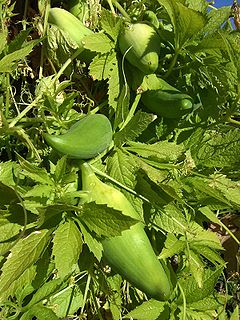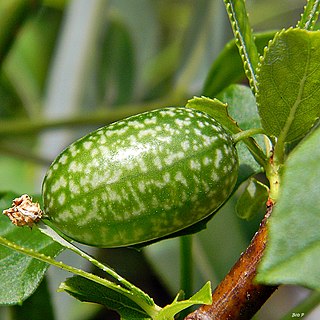
The Cucurbitales are an order of flowering plants, included in the rosid group of dicotyledons. This order mostly belongs to tropical areas, with limited presence in subtropic and temperate regions. The order includes shrubs and trees, together with many herbs and climbers. One major characteristic of the Cucurbitales is the presence of unisexual flowers, mostly pentacyclic, with thick pointed petals. The pollination is usually performed by insects, but wind pollination is also present.

The Cucurbitaceae, also called cucurbits or the gourd family, are a plant family consisting of about 965 species in around 95 genera, of which the most important to humans are:

Bryonia is a genus of flowering plants in the gourd family. Bryony is its best-known common name. They are native to western Eurasia and adjacent regions, such as North Africa, the Canary Islands and South Asia.

Cucumis is a genus of twining, tendril-bearing plants in the family Cucurbitaceae which includes the cucumber, muskmelons, the horned melon, and the West Indian gherkin.

Momordica is a genus of about 60 species of annual or perennial climbers herbaceous or rarely small shrubs belonging to the family Cucurbitaceae, natives of tropical and subtropical Africa and Asia and Australia. Most species produce floral oils and are visited by specialist pollinators in the apid tribe Ctenoplectrini. A molecular phylogeny that includes all species is available.

The bee tribe Ctenoplectrini of the subfamily Apinae, with the two genera Ctenoplectra and Ctenoplectrina, comprises 9 species in tropical Africa, 10 in Asia, and 1 in Australia.

Sicyos is a flowering plant genus of the family Cucurbitaceae. Members of the genus are commonly known as burr cucumbers.

Tetrameles is a genus of flowering plants in the family Tetramelaceae with one species, Tetrameles nudiflora or spung tree. It grows as a large deciduous tree and is found across southern Asia from India through southeast Asia, Malesia, and into northern Australia.

Dendrosicyos is a monotypic genus in the plant family Cucurbitaceae. The only species is Dendrosicyos socotranus, the cucumber tree. The species is endemic to the island of Socotra in Yemen, and is the only species in the Cucurbitaceae to grow in a tree form. The species name was originally spelled D. socotrana, but this is corrected to masculine grammatical gender according to the International Code of Nomenclature for algae, fungi, and plants.
Tumamoca macdougalii Rose is a member of the Cucurbitaceae or gourd family. Also called the Tumamoc globeberry, it is native to a very narrow area of the Sonoran Desert, and is found in both Sonora and Arizona. It is one of two species in genus Tumamoca.
Tumamoca is a plant genus in the family Cucurbitaceae. It is named for Tumamoc Hill just west of the City of Tucson, Arizona, where the University of Arizona maintains an ecological research station. The type specimen of T. macdougalii was collected near the station.

The Cucurbiteae are a tribe of the subfamily Cucurbitoideae, which is part of the flowering plant family Cucurbitaceae (gourds). Species are usually monoecious herbaceous annuals or woody lianas.

Cucurbita andreana is a plant species of the genus Cucurbita, since 1982 in the rank of a C. maxima subspecies, C. maxima subsp. andreana, the wild relative of C. maxima subsp. maxima cultivated subspecies. It is native to Argentina and Uruguay. C. andreana fruits are smaller and not palatable, those of C. maxima are bigger and palatable.

Cayaponia is the largest genus in the gourd family, Cucurbitaceae, with about 60 species. The plants are referred to as melonleaf. They are common from the southern United States to South America. Some species are also found in western Africa, Madagascar, and Fernando de Noronha, which is about 354 km off the coast of Brazil. It is native the southern United States to central South America and the Caribbean islands. Most species are found in rainforests and have white or yellow-green flowers. The original Cayaponia were pollinated by bats, but at least two shifts to bee pollination have occurred among some of its species. This is apparently the first clade to shift from bat to bee pollination vice bee to bat pollination. A 2011 study based on genetics placed the genus Selysia under this genus.
Selysia is a genus of the gourd family. A 2011 study based on genetics placed it under the genus Cayaponia.
Selysia bidentata is a species of the genus Selysia native to Panama. It is high similarity to S. smithii. It has ovate seeds and there are 6–9 in each fruit. The fruits turn from green to red at maturity. The leaves have three lobes. Selysia bidentata can be distinguished from the 3 other species of Selysia by its bidentate seeds. Seeds of the other three species are shaped like arrowheads.

Cyclanthera is a genus of flowering plants in the family Cucurbitaceae. The name comes from the fact that some species show extreme cases of stamen fusion forming a ring around the gynoecium, with a single locule.

Melothria is a genus of flowering plants in the family Cucurbitaceae, native to the Americas from the United States to Argentina, and with some introductions in Africa and elsewhere. A number of Old World species formerly in Melothria were reassigned to Cucumis.

Echinopepon is a genus of flowering plants in the family Cucurbitaceae, native to the southwestern United States, Mexico, Central America, and South America. Tendrillate vines, their prickly fruits are operculate, with the prickles themselves being stipitate glandular.















